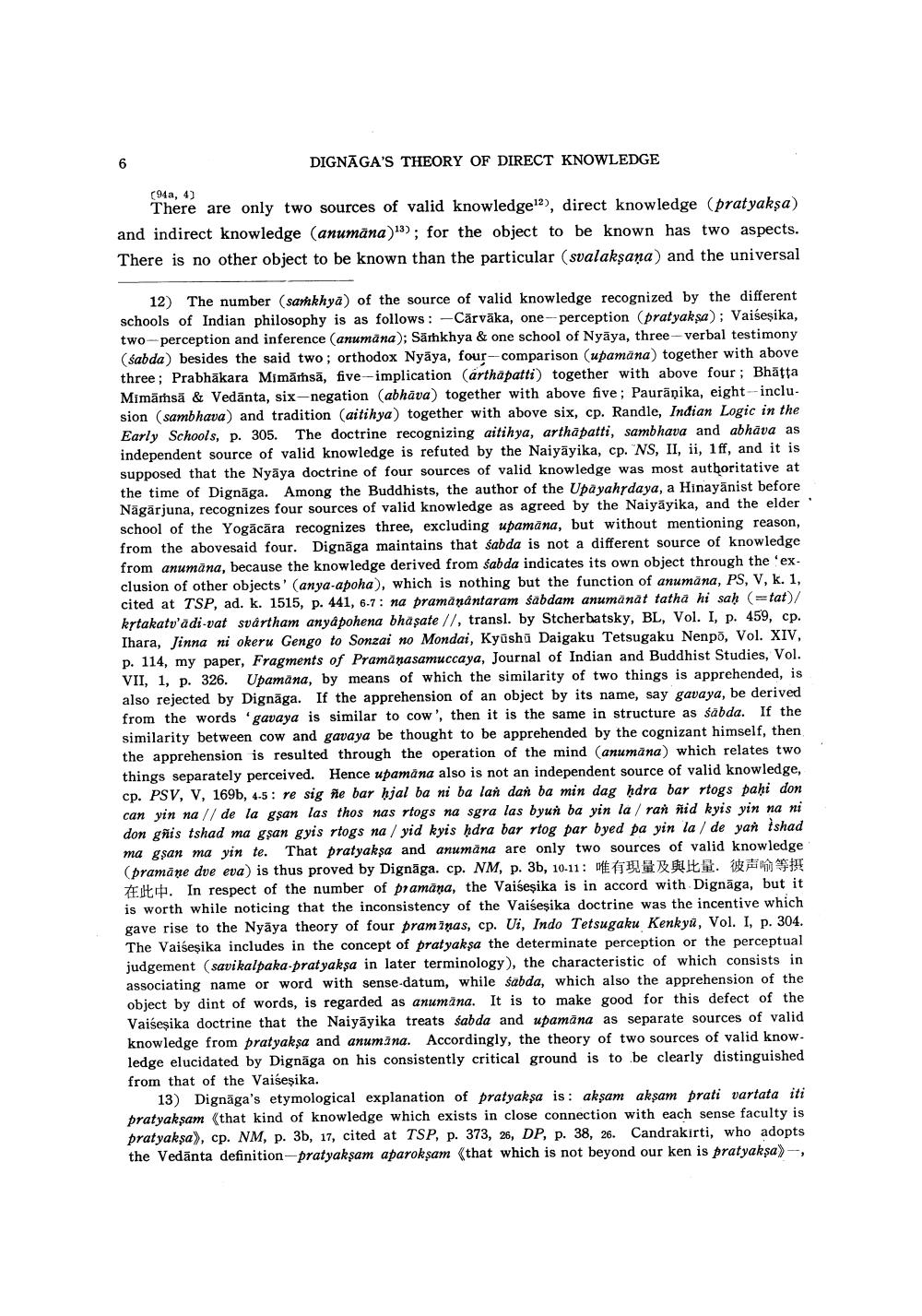Book Title: Dignagas Theory Of Direct Knowledge Author(s): Massaki Hattori Publisher: Massaki Hattori View full book textPage 6
________________ DIGNAGA'S THEORY OF DIRECT KNOWLEDGE (94a, 4) There are only two sources of valid knowledge!2), direct knowledge (pratyaksa) and indirect knowledge (anumana)13); for the object to be known has two aspects. There is no other object to be known than the particular (svalaksana) and the universal ber (samkhya) of the source of valid knowledge recognized by the different schools of Indian philosophy is as follows: Carvaka, one---perception (pratyaksa); Vaisesika, two-perception and inference (anumana); Sarkhya & one school of Nyaya, three-verbal testimony (sabda) besides the said two; orthodox Nyaya, four-comparison (upamana) together with above three; Prabhakara Mimarsa, five-implication Carthapatti) together with above four; Bhatta Mimamsa & Vedanta, six-negation (abhava) together with above five; Pauranika, eight-inclusion (sambhava) and tradition (aitihya) together with above six, cp. Randle, Indian Logic in the Early Schools, p. 305. The doctrine recognizing aitihya, arthapatti, sambhava and abhava as independent source of valid knowledge is refuted by the Naiyayika, cp. "NS, II, ii, 1ff, and it is supposed that the Nyaya doctrine of four sources of valid knowledge was most authoritative at the time of Dignaga. Among the Buddhists, the author of the Upayahrdaya, a Hinayanist before Nagarjuna, recognizes four sources of valid knowledge as agreed by the Naiyayika, and the elder the Yogacara recognizes three, excluding upamana, but without mentioning reason, from the abovesaid four. Dignaga maintains that sabda is not a different source of knowledge from anumana, because the knowledge derived from sabda indicates its own object through the 'exclusion of other objects' (anya-apoha), which is nothing but the function of anumana, PS, V, k. 1, cited at TSP, ad. k. 1515, p. 441, 6-7: na pramanantaram sabdam anumanat tatha hi sah (=tat)/ krtakatv'adi-vat svartham anyapohena bhasate //, transl. by Stcherbatsky, BL, Vol. I, p. 459, cp. Ihara, Jinna ni okeru Gengo to Sonzai no Mondai, Kyushu Daigaku Tetsugaku Nenpo, Vol. XIV, p. 114, my paper, Fragments of Pramanasamuccaya, Journal of Indian and Buddhist Studies, Vol. VII, 1, p. 326. Upamana, by means of which the similarity of two things is apprehended, is also rejected by Dignaga. If the apprehension of an object by its name, say gavaya, be derived from the words 'gavaya is similar to cow', then it is the same in structure as sabda. If the similarity between cow and gavaya be thought to be apprehended by the cognizant himself, then the apprehension is resulted through the operation of the mind (anumana) which relates two things separately perceived. Hence upamana also is not an independent source of valid knowledge, cp. PSV, V, 169b, 4-5: re sig ne bar hjal ba ni ba lan dan ba min dag hdra bar rtogs pahi don can yin na // de la gsan las thos nas rtogs na sgra las byun ba yin la/ ran nid kyis yin na ni don gnis tshad ma gsan gyis rtogs na / yid kyis hdra bar rtog par byed pa yin la / de yan ishad ma gsan ma yin te. That pratyaksa and anumana are only two sources of valid knowledge (pramane dve eva) is thus proved by Dignaga. cp. NM, p. 3b, 10-11: HORI . $ E t. In respect of the number of pramana, the Vaisesika is in accord with Dignaga, but it is worth while noticing that the inconsistency of the Vaisesika doctrine was the incentive which gave rise to the Nyaya theory of four praminas, cp. Ui, Indo Tetsugaku Kenkyu, Vol. I, p. 304. The Vaisesika includes in the concept of pratyaksa the determinate perception or the perceptual judgement (savikalpaka-pratyaksa in later terminology), the characteristic of which consists in associating name or word with sense-datum, while sabda, which also the apprehension of the object by dint of words, is regarded as anumana. It is to make good for this defect of the Vaisesika doctrine that the Naiyayika treats sabda and upamana as separate sources of valid knowledge from pratyaksa and anumana. Accordingly, the theory of two sources of valid knowledge elucidated by Dignaga on his consistently critical ground is to be clearly distinguished from that of the Vaisesika. 13) Dignaga's etymological explanation of pratyaksa is : aksam aksam prati vartata iti pratyaksam (that kind of knowledge which exists in close connection with each sense faculty is pratyaksa), cp. NM, p. 3b, 17, cited at TSP, p. 373, 26, DP, p. 38, 26. Candrakirti, who adopts the Vedanta definition-pratyaksam aparoksam (that which is not beyond our ken is pratyaksa) ,Page Navigation
1 ... 4 5 6 7 8 9 10 11 12 13 14 15 16 17 18 19 20
